Ceiling split system: types of equipment and features of its installation + rating of the TOP 10 best models
Modern ceiling-type air conditioning systems are distinguished by a wide variety of designs, appearance and installation features.Are you thinking about purchasing such a device, but don’t know which one is best to choose to equip your room? We will help you make the right choice so that you can choose the appropriate equipment option for your apartment, home or office.
Let's figure out together what a split ceiling system is and what the specifics of its operation are. We will also consider popular types of equipment, their design features, and the nuances of choosing and installing climate control equipment.
Additionally, the article contains photos, diagrams and video instructions that will help you thoroughly understand the issue of choosing ceiling-type split systems.
The content of the article:
Types and design of ceiling systems
Ceiling type devices are one of the types of air conditioners for domestic and semi-industrial use. Consists of two blocks: compressor-condenser - for outdoor installation, and an evaporative device intended for indoor installation.
Some models are distinguished by the presence of additional optional features, for example, they heat the air and carefully filter it.
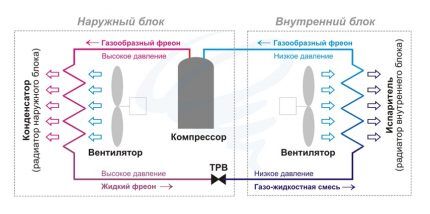
Let's look at the most popular types of ceiling-mounted air conditioners.
Type #1 - cassette air conditioning system
This type of device is considered the optimal solution for facilities where uniform distribution of cooled air flows is important. The devices are installed in the interceiling space, so they are suitable for any interior and do not spoil its appearance, like wall-mounted systems.
Most often, products are used to equip apartments, houses, cottages with high ceilings - more than 3 meters, offices, halls, cinema halls, shopping centers, restaurants and other large premises.
Also, cassette devices can be used as one or more elements of a multi-split system: they are designed to maintain the necessary microclimate in several office premises, shops, warehouses, etc.
The design of the equipment includes 2 autonomous blocks for internal and external placement, connected by a route.
Mostly on the market there are square-shaped models of standard sizes - about 600 mm on each side. They differ in different cooling and heating power, functionality and level of energy savings.
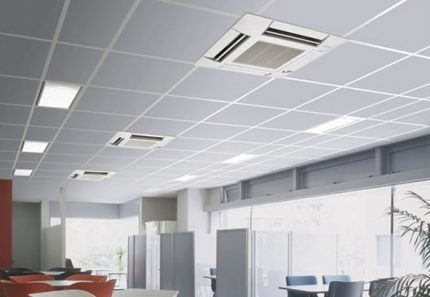
One of the advantages of cassette systems is the concealment of the device’s communications in the suspended part of the ceiling.
In the center of the structure of the indoor unit there is a decorative grille, on the sides of which there are 4 exit slots with rotating blinds. The grille performs the function of taking in warm air, which occurs due to the operation of an axial fan.
Next, the air masses pass through the evaporator heat exchanger, where the cooling process occurs. The working substance for moving the heat energy of air flows is freon.
The already cooled masses are returned to the room and distributed evenly due to adjustable blinds. Their inclination level can be changed using the control panel.
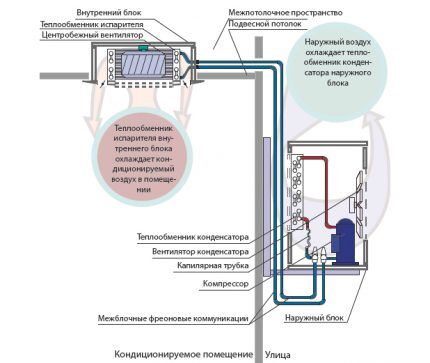
The external unit of the technical device is installed on the facade of the building and is connected to the internal structure using a line of copper pipes for refrigerant circulation.
The main advantages of the cassette type system:
- air flow distribution in 4 directions;
- rapid cooling/heating of air;
- neat design of the decorative panel;
- low noise level.
Some models are distinguished by the presence of such functions as air ventilation, automatic temperature maintenance, night mode of use, self-diagnosis of system errors and malfunctions, remembering selected settings, preventing the formation of ice, and others.
In addition, the system also has some disadvantages - high cost, compared to wall-mounted devices, and the possibility of installation only in the space between the main and suspended parts of the ceiling structure. This type of device is not suitable for apartments with ceilings with a height of 250-270 cm.
We discussed the issue of installing a cassette split system in more detail in another our article.
Type #2 - duct split system
The devices have a similar design to the previous type. The main distinctive feature of the technology is the implementation of supply and exhaust ventilation due to the air channel.
Such systems are installed in multi-room apartments, offices, shops and other large premises.
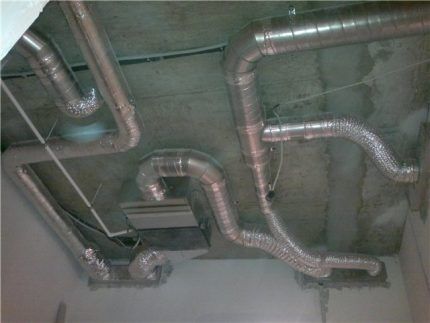
The external part is a structure consisting of the main block, supply and outlet air ducts. The number of air ducts can be adjusted independently depending on the area that needs to be conditioned.
The indoor unit is placed inside the ceiling structure, so that the communication system and the device housing are hidden above the suspended ceiling. The installation location of the unit should be selected in the middle of the house or other room in order to evenly distribute the air ducts.
In the hidden part of the ceiling of the rooms the required amount is installed air ducts to ensure air conditioning of all rooms. Each of its exits is covered with a decorative panel with a grille.
In the inner part of the structure there is an evaporator heat exchanger and a fan. The unit is also equipped with an air filter, temperature sensors, and a remote control signal receiving unit.

The duct unit is designed for conditioning recirculated air. However, its special design makes it possible to cool/heat masses with up to 30% fresh air.
Often this type of ceiling air conditioners is used in supermarkets or large offices, where the ceilings are quite high and there is no need to select the temperature for each room individually.
For the entry of fresh air masses, a special channel is provided through which they are supplied to the indoor unit for processing.
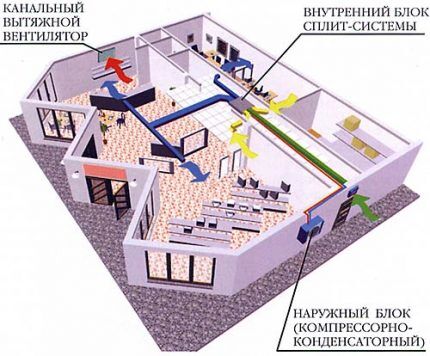
The external design of the system is equipped with such necessary elements as a condenser heat exchanger with a fan, a compressor, a protection device, a control unit and an external part - the housing. The block should be placed on the outer wall of the building with minimal access to sunlight.
The advantages of the unit include the following aspects:
- minimal intervention in the design of the room;
- you can air condition several or one large room at the same time;
- Cooling and warming of air flows is possible even with constant addition of fresh air.
In addition to the advantages, users also highlight some negative aspects of using a channel-type device.
For example, the main disadvantages are:
- maintaining a uniform temperature regime without the possibility of regulating it in different rooms;
- Can be installed only in rooms with high ceilings;
- for installation, you will need to use the services of specialists in order to correctly position the air ducts and the entire system as a whole;
- high cost of the system.
The duct type of ceiling air conditioners is distinguished by the ability to maintain a constant temperature, and some models are equipped with an air dehumidification function and can operate in night mode.
The average price for such devices is 60-80 thousand rubles, and premium ones are offered from 120 thousand rubles.
Type #3 - floor-ceiling devices
The devices are distinguished by the possibility of installing them under the ceiling, and, if necessary, on the floor.
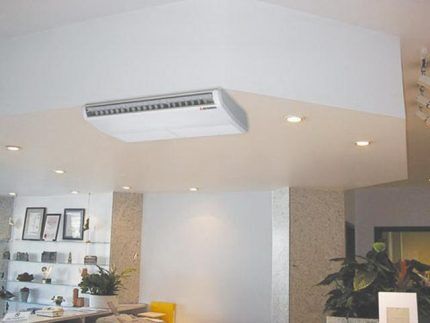
The internal body of the device has a flat design, so it does not visually clutter up the space. It can be installed in a vertical or horizontal position: the wider part can be fixed to the wall or ceiling.
Ceiling units are intended for use in domestic and commercial premises - living rooms, warehouses and utility rooms, cafes, cinema complexes, etc.
Functionally, this type performs the following actions: cooling, heating, cleaning air flows.
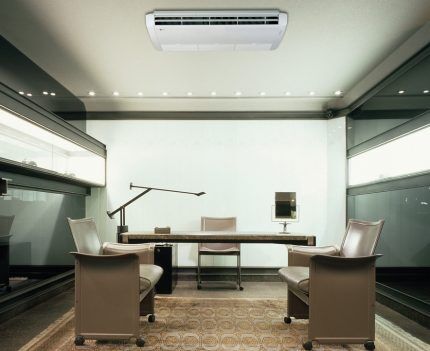
The function of heating air masses is possible only by those devices that are equipped with a heat pump.
The internal structure of the device consists of the following elements:
- frame – external part of the device;
- evaporator heat exchanger – performs the function of removing heat from air flows in cooling mode;
- internal centrifugal fans – capture air masses from the room, moving them through the heat exchanger and filter elements;
- control unit – designed to enable the necessary functions.
Filtration of conditioned air occurs due to the air filter element, which is also located in the indoor unit.
The external structure of the system is installed on the wall of the building and connected to the internal one using an interblock freon route.
The design of the device is similar to previous types of ceiling units. Its main functional elements are a heat exchanger and a condenser fan, a compressor, a control board, and a protection device.

The functional element is combined with the internal circuit through freon communications, which form a single closed system.
The advantages of this type of air conditioner include uniform distribution of air conditioning air flows throughout the room, the possibility of installation on any type of ceiling, low noise level and low cost of installation work.
The negative aspects of the devices are their high cost and the inability to install them in the ceiling space.
Rating of ceiling split systems
Hyundai H-ALC3-18H
Immaculately assembled cooling and heating unit
The ceiling-type climate system cools and heats rooms whose area does not exceed 54 square meters. m. Reduces air humidity at a rate of 1.8 l/h, performs ventilation in three speed modes. The model is in demand mainly in the arrangement of commercial, industrial, and office premises.
The minimum temperature supported by the equipment is +17ºС. The split system is equipped with a timer to reschedule the start and a display to track performance characteristics. An infrared remote control is included for ease of control.
Specifications:
- modes - cooling, heating, dehumidification, ventilation;
- power (cooling/heating) - 5300 W/5900 W;
- power consumption (cooling/heating) - 1712 W/1793 W;
- maximum volume of air supply - 21.67 cu.m. m/min;
- length of communications – up to 25 m;
- minimum temperature when heating - 15ºС;
- cleaning devices – coarse filter;
- weight of blocks (indoor/outdoor) - 20/42 kg;
- energy efficiency class - B;
- additional functionality - automatic support of the set temperature, memorization of settings, self-diagnosis, timer, display, air flow direction adjustment, night mode, anti-icing system;
- noise level (min/max) - 34/41 dB
The unit works perfectly in all available modes. It operates quite quietly and does not interfere with the owners’ rest. Heating is carried out on cool and frosty days, during which the temperature does not drop below -15ºС.
The list of disadvantages is headed by low energy efficiency. The owners are not pleased with the lack of a device for fine filtration, ionization and deodorization of the air mass. The price is not too tempting to buy.
- Stable operation in all modes
- Simple, intuitive controls
- Environmentally friendly refrigerant
- High quality build
- Lightweight indoor unit
- Low energy efficiency
- Insufficient degree of air purification
Timberk AC TIM 36LC CF5
Powerful and efficient cooling and heating equipment
The floor-ceiling version of the split system will qualitatively heat and cool the air in rooms whose area does not exceed 100 square meters. m. Eliminates excess moisture and ventilates in three different speed modes. Ideal for arranging shopping malls, restaurants, and sports complexes.
The design is equipped with a timer that allows you to reschedule the launch to the optimal time for the owners. The control uses an infrared remote control. Split heating will be carried out at a temperature outside the window not lower than -15ºС.
Specifications:
- modes - cooling, heating, dehumidification, ventilation;
- power (cooling/heating) - 10600 W/11700 W;
- power consumption (cooling/heating) - 3772 W/3500 W;
- maximum volume of air supply - 25.0 cu. m/min;
- length of communications – up to 50 m;
- minimum temperature when heating - 15ºС;
- cleaning devices – coarse filter;
- weight of blocks (indoor/outdoor) - 33/71 kg;
- energy efficiency class - C;
- additional functionality - automatic support of the set temperature, memorization of settings, self-diagnosis, timer, adjustment of air flow direction, night mode, anti-icing system;
- noise level (minimum/maximum) - 41/50 dB.
The climate system is filled with environmentally friendly refrigerant. Its use causes a rather low energy efficiency of the installation.
The disadvantage is the lack of a multi-level cleaning system, as well as devices for ionization and deodorization of the processed air. Not everyone is satisfied with the noise level at normal settings. But when switching to night mode, sound interference decreases.
- High air processing speed
- High quality build
- Environmentally friendly refrigerant
- Self-diagnosis for timely detection of problems
- Flawless operation in all modes
- Low energy efficiency
- Noise at normal settings
- Insufficient degree of air purification
Shivaki SFH-184BE/SUH-184BE
Universal floor-ceiling model
The split system developed by the Japanese perfectly copes with cooling and heating rooms whose area does not exceed 50 square meters. m. The universal unit dehumidifies air at a speed of 1.9 l/hour. If necessary, the model plays the role of a fan.
The climate control system is extremely easy to control. Comfort of control is ensured by the presence of an infrared remote control. There is a timer to postpone the start of work.
Specifications:
- modes - cooling, heating, dehumidification, ventilation;
- power (cooling/heating) - 5300 W/5900 W;
- power consumption (cooling/heating) - 1900 W/1690 W;
- maximum volume of air supply - no data;
- minimum temperature during heating - 7ºС;
- cleaning devices – coarse filter;
- weight of blocks (indoor/outdoor) - 28/41 kg;
- energy efficiency class - A;
- additional functionality - automatic support of the set temperature, memorization of settings, self-diagnosis, timer, adjustment of air flow direction, anti-icing system;
- noise level (minimum/maximum) - 43/53 dB.
The system is equipped with a conventional compressor, but has relatively low energy consumption. Filled with environmentally friendly freon. Significant advantages include affordable price. Not all owners of an air conditioner are satisfied with the noise during fan operation.
- Impeccable build quality
- Economical energy consumption
- Self-diagnosis for timely detection of problems
- Simple and convenient control
- Environmentally friendly refrigerant
- Fan noise
- Heating only down to -7ºС
- Insufficient degree of air purification
Toshiba RAS-B10UFV-E/RAS-10SAV2-E
Excellent model with multi-stage air purification
The indoor unit of the Thai climate system can be mounted both on the floor and on the ceiling. The unit produces cooling, heating, lowers humidity levels and ventilates air in domestic premises. The equipment is equipped with an inverter type compressor, which ensures smooth start-up and stable operation.
The model is simple and extremely easy to use. It can be used in floor heating. An infrared remote control is included for ease of control. A timer allows you to select the optimal time to start processes.
Specifications:
- modes - cooling, heating, dehumidification, ventilation;
- power (cooling/heating) - 2500 W/3200 W;
- power consumption (cooling/heating) - 600 W/750 W;
- maximum volume of air supply - 7.78 cubic meters. m/min;
- length of communications – up to 15 m;
- minimum temperature when heating - 15ºС;
- cleaning devices – coarse and fine filters, deodorizing filter;
- weight of blocks (indoor/outdoor) - 14/35 kg;
- energy efficiency class - A;
- additional functionality - automatic support of the set temperature, memorization of settings, self-diagnosis, timer, adjustment of air flow direction, night mode, anti-icing system;
- noise level (minimum/maximum) - 23/39 dB.
Owners of this climate control equipment note that there are no drafts during its operation. Consequently, it is ideal for arranging children's rooms, and indeed all frequently visited rooms in general. The only disadvantages include the too high price.
- High air processing speed
- Multi-level cleaning system
- Self-diagnosis for timely detection of problems
- Environmentally friendly refrigerant
- Possibility to heat the floor
- Unnecessarily high price
Mitsubishi Electric MFZ-KJ25VE / MUFZ-KJ25VE
Flawlessly working split system with wide functionality
The indoor unit of the split system is universal - it can be installed on the floor or mounted on the ceiling. This model is designed to create an optimal microclimate in rooms up to 20 square meters. m. Heats, cools, reduces humidity levels, ventilates in five speed modes.
Comfortable control of the system is provided by an infrared remote control. A timer allows you to reschedule the start of air treatment to a time convenient for the owners.
Specifications:
- modes - cooling, heating, dehumidification, ventilation;
- power (cooling/heating) - 2500 W/3400 W;
- power consumption (cooling/heating) - 540 W/770 W;
- maximum volume of air supply - 8.20 cubic meters. m/min;
- length of communications – up to 20 m;
- minimum temperature when heating - 15ºС;
- cleaning devices – coarse filter, deodorizing filter;
- weight of blocks (indoor/outdoor) - 15/37 kg;
- energy efficiency class - A;
- additional functionality - automatic support of the set temperature, memorization of settings, self-diagnosis, timer, adjustment of air flow direction, night mode, anti-icing system;
- noise level (minimum/maximum) - 20/39 dB.
The presence of a deodorizing filter ensures quick removal and neutralization of unpleasant odors.However, the split is not equipped with a fine filter that collects dust suspended in the air - this is a minus for equipment in this price category.
- High air processing speed
- Environmentally friendly refrigerant
- Self-diagnosis for timely detection of problems
- Low noise level
- Economical energy consumption
- Unnecessarily high price
LG UV36/UU37
Powerful climate control unit that works flawlessly
This model is designed for cooling and heating rooms up to 108 square meters. m. The indoor unit can be installed on the floor or fixed on the ceiling under a suspended or plasterboard ceiling system. If necessary, the unit lowers the humidity level and ventilates in three speed modes.
Control is carried out using an infrared remote control. A timer allows you to delay the start of the split system for the required period.
Specifications:
- modes - cooling, heating, dehumidification, ventilation;
- power (cooling/heating) - 10000W/11000W;
- power consumption (cooling/heating) - 3720 W/3780 W ;
- maximum volume of air supply - 29.0 cu. m/min;
- length of communications - no data;
- minimum temperature when heating is 20ºС;
- cleaning devices – coarse filter, antibacterial filter;
- weight of blocks (indoor/outdoor) - 35/85 kg;
- energy efficiency class - A;
- additional functionality - automatic support of the set temperature, memory of settings, timer, night mode, anti-icing system;
- noise level (minimum/maximum) - 40/44 dB.
A justified advantage of the model is the presence of an antibacterial filter.It will work in heating mode down to -20ºС outside - also a significant advantage. But the cost of equipment does not encourage everyone to purchase and install it.
- High air processing speed
- Economical energy consumption
- Availability of antibacterial filter
- Environmentally friendly refrigerant
- Flawless operation in all modes
- Unreasonably high price
IGC IFM-18H/U
Efficient system at an affordable price
The split system quickly cools and heats residential, office and commercial premises up to 50 square meters. m. Dries the air and performs ventilation if necessary. It is popular among owners of apartments and private houses, small commercial establishments, production shops, and workshops.
The indoor unit can be placed on the floor or fixed to the ceiling, covered with a tension or plasterboard ceiling system. For convenience, the model comes with an infrared remote control.
Specifications:
- modes - cooling, heating, dehumidification, ventilation;
- power (cooling/heating) - 5100 W/5500 W;
- power consumption during cooling -2950 W;
- maximum volume of air supply - 21.67 cubic meters. m/min;
- length of communications – up to 25 m;
- minimum temperature when heating - 15ºС;
- cleaning devices – coarse filter;
- weight of blocks (indoor/outdoor) - 24/36.5 kg;
- energy efficiency class - no data;
- additional functionality - automatic support of the set temperature, memorization of settings, self-diagnosis, timer, adjustment of air flow direction, night mode, anti-icing system;
- noise level (minimum/maximum) - 43/58 dB.
The minimum temperature limit in cooling mode is -17ºС. Consumers consider the reasonable price to be an undeniable advantage. They consider the disadvantage to be an insufficient degree of filtration, i.e. lack of a fine filter.
- High quality build
- Self-diagnosis to identify faults
- Affordable price
- Insufficient degree of air purification
GENERAL AGHG09LVCB
Split system that improves air composition
GENERAL AGHG09LVCB will quickly and efficiently cool or warm the air in a room up to 25 square meters. m. The equipment reduces the humidity level at a rate of 1.3 l/h and performs ventilation. The model is purchased by owners of apartments and private houses.
The timer allows you to postpone the start of air treatment to a time convenient for the owners. Ease of control is enhanced by the presence of an infrared remote control; the mode selection scheme is extremely simple and understandable. Integration into the Smart Home system is provided.
Specifications:
- modes - cooling, heating, dehumidification, ventilation;
- power (cooling/heating) - 2600 W/3500 W;
- power consumption (cooling/heating) - 530 W/790 W;
- maximum volume of air supply - 9.50 cubic meters. m/min;
- length of communications – up to 20 m;
- minimum temperature when heating - 25ºС;
- cleaning devices - coarse and fine filters, deodorizing filter;
- weight of the outdoor unit - 54 kg;
- energy efficiency class - A++;
- additional functionality - anion generator, automatic support of the set temperature, memorization of settings, self-diagnosis, timer, air flow direction adjustment, night mode, anti-icing system;
- noise level (minimum/maximum) - 22/40 dB.
The list of justified advantages is headed by the use of an inverter compressor. Owners of this technique really like the multi-level cleaning system, complemented by a deodorizing filter and an anion generator.
The system heats until the temperature outside the window drops by more than -25ºС. The only disadvantage is the high price.
- Multi-stage air purification system
- Wide temperature range
- Environmentally friendly refrigerant
- High price
Electrolux EACU-18H/UP2/N3
Equipment with “average” characteristics and price
The Electrolux EACU-18H/UP2/N3 split system perfectly copes with air treatment in rooms up to 50 square meters. m. Its internal module can be placed at floor level or on the ceiling. Multifunctional equipment reduces humidity levels and provides ventilation. It is purchased mainly by owners of small commercial enterprises, less often by owners of private houses.
The split system is simple and convenient to operate; there is a remote control for remote control. It can be integrated into the Smart Home equipment complex, linked to fire alarm sensors or to devices that respond to an open door. There is a timer to reschedule the start of air treatment.
Specifications:
- modes - cooling, heating, dehumidification, ventilation;
- power (cooling/heating) - 5000W/5500W;
- power consumption (cooling and heating) - 1600 W;
- maximum volume of air supply - 13.33 cubic meters. m/min;
- length of communications – up to 20 m;
- minimum temperature when heating - 10ºС;
- cleaning devices – coarse filter;
- weight of blocks (internal/external) - 27/37 kg;
- energy efficiency class - A;
- additional functionality - automatic support of the set temperature, memorization of settings, self-diagnosis, timer, air flow direction adjustment, night mode, anti-icing system, warm start;
- noise level (minimum/maximum) - 34/43 dB.
The unit will operate for heating only down to -15ºС, this is not bad, but there are splits with a wider temperature range. The unit has a fairly high class in terms of economical energy consumption, but it is also not the most economical model.
The system does not perform fine cleaning, does not ionize or deodorize the air mass being processed, which can be considered a disadvantage. Otherwise, the model is a simple and not too expensive “mid-range”.
- High air processing speed
- Acceptable price
- Self-diagnosis to identify problems
- Possibility of integration into the Smart Home system
- Environmentally friendly refrigerant
- Low degree of air purification
Royal Clima CO-F36HN
Powerful split system for offices and production
The climate system Royal Clima CO-F36HN will perfectly cool and heat rooms up to 100 square meters. m. If necessary, reduce the level of humidity in the air and perform ventilation. The model is popular among owners of commercial establishments, small businesses, and gyms. Less commonly purchased by owners of country houses and city apartments.
Even completely inexperienced users will not have any problems managing the system. For the convenience of selecting a mode and sending commands, an infrared remote control is included with the unit. The timer allows you to reschedule the launch to the desired time.
Specifications:
- modes - cooling, heating, dehumidification, ventilation;
- power (cooling/heating) - 10600 W/11700 W;
- power consumption (cooling/heating) -3770 W/3500 W;
- maximum volume of air supply - 25.0 cubic meters. m/min;
- length of communications – up to 30 m;
- minimum temperature when heating - 15ºС;
- cleaning devices – coarse filter;
- weight of blocks (indoor/outdoor) - 34/89 kg;
- energy efficiency class - no data;
- additional functionality - automatic support of the set temperature, memorization of settings, self-diagnosis, timer, adjustment of air flow direction, night mode, anti-icing system;
- noise level (minimum/maximum) - 41/50 dB.
The system is powered from a three-phase network, which by default limits its scope of application. It does not perform fine air purification and ozonation. However, for such powerful equipment it has an affordable price.
- High air processing speed
- Self-diagnosis to identify problems
- Environmentally friendly refrigerant
- Insufficient degree of air filtration
- Noisy operation during ventilation
Recommendations for choosing devices
When purchasing climate control equipment, you should pay attention to the configuration, appearance, and also take into account technical indicators that affect the performance of the system. Let us consider in more detail the main criteria for the correct selection of equipment.
Brand and class level
Like all devices, split systems are produced in budget, medium and premium versions, which differ in cost and functionality.It is better to purchase a unit from a popular manufacturer with a good reputation.

The most popular brands of cassette devices are Shivaki, Electrolux And Hisense. However, the cost of these devices varies between 70-100 thousand rubles. Brands in demand among duct equipment Mitsubishi Electric, Haier, General Climate. The price range for them is from 40 to 120 thousand rubles. Users named the following best brands of floor-ceiling units: Panasonic, Shivaki, Daikin And LG. These brands produce mid- and premium-class equipment.
Determination of equipment power
Another important criterion is the power in the air mass cooling mode. This indicator is expressed in British thermal units, the English abbreviation is BTU. 1 BTU equals 0.3 watts.
The specifications for a device may indicate the cooling capacity in BTUs or electrical watts, which can help determine the size of the room the unit is suitable for.
Since cooled air flows move down and concentrate near the floor, when selecting a unit, it is not the volume of space that is taken into account, but its area.
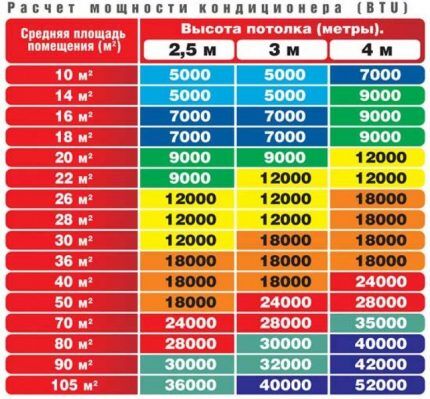
Based on the tabular data, for small rooms up to 25 m2 split systems with a capacity of 7 or 9 BTU are suitable, and for spacious rooms of 50-60 m2 it is better to buy with an indicator of 18, 24 BTU.We discussed the issue of calculating system power in more detail in this article.
Noise level of climate control equipment
This indicator is very important for those who plan to install an air conditioning system in a bedroom or library. In such rooms the user often rests, and excess noise will distract him.
Therefore, to equip an apartment, house or other residential building, it is recommended to use devices with low noise levels - 26-36 dB for an indoor unit and up to 54 dB for an outdoor structure.
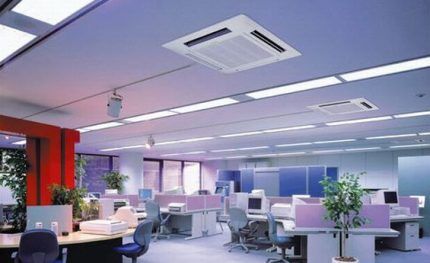
Rules for installing split systems
Comfort in the room where you plan to install an air conditioning system depends not only on the technical parameters of the device, but also on the correctness of its installation.

Therefore, it is better to initially perform all the steps correctly in order to save on repairs or purchase of new climate control equipment.
Let's take a step-by-step look at how to properly install the ceiling system.
Stage #1 - installation of equipment units
Depending on the type of ceiling air conditioner, you should decide on the future location of the internal structure. Cassette and duct units are installed in the free area between the main and suspended ceilings.
The internal part of the cassette unit is installed in special hangers, which are secured using anchor bolts in one or more cells of the suspended ceiling.
The duct type of equipment may have several air ducts in each room, which are connected to the indoor unit and connected to distribution grilles. The installation is carried out above a suspended structure, so it is better to do it before installing the ceiling.
The number and length of air ducts are determined based on the parameters and area of the room. We recommend that you read calculation rules air ducts
After installing the structure, the air ducts are insulated and soundproofed to prevent the formation of condensation and increased noise during operation.
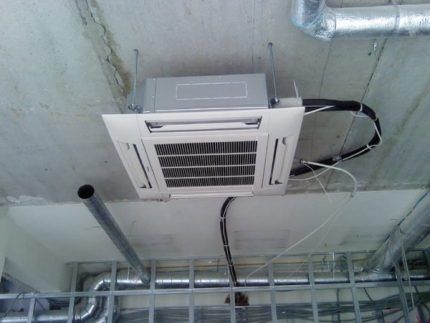
Floor-ceiling units are attached to the ceiling using fastening bolts with M10 threads with strict adherence to horizontality. If necessary, the ceiling structure is strengthened and leveled.
Installation steps:
- Drilling a hole in the wall with access to the street with a diameter of 55 mm.
- Laying a cable duct from the hole to the indoor unit.
- Selecting the optimal location and marking future holes for brackets to securely fasten the outdoor unit.
- Drilling holes, securing brackets, installing an external unit.
- Installation of the internal structure depending on the type of split system.
- Connecting the drainage system to the internal structure.
- Electrical connection to the system.
- Laying the route: thermal insulation is put on the copper pipeline, the tubes are flared and connected to two blocks.
The tightness of the structure depends on the reliability of the connection of the tubes with the external and external units, which directly affects the performance of the device.
Stage #2 - pressure testing and evacuation of the system
After laying interblock communications, the main line is checked for integrity and tightness.
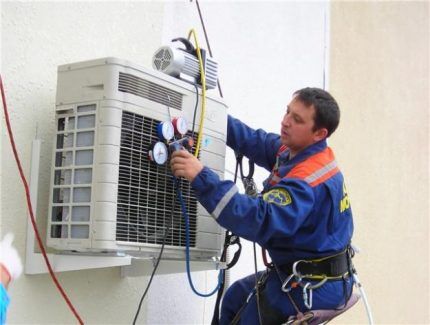
When it is determined that the system is tight, the line is filled with refrigerant.
Most models of units use two-component freon R 410A without chlorine, which is safe for the ozone layer.
If the route is long enough, then additional refilling of the air conditioning system with refrigerant will be required. Features of self-refueling system we reviewed here.
Stage #3 - commissioning
After assembling the system, evacuating it and filling it with freon, you will need to check the operation of the device and make sure there are no leaks. To do this, you need to turn on the device and run it in all operating modes.
When the functionality of the device has been verified, it is necessary to perform the final steps: seal the groove with polyurethane foam, silicone sealant, cement mortar, and also remove debris, dust and remaining materials in the room.
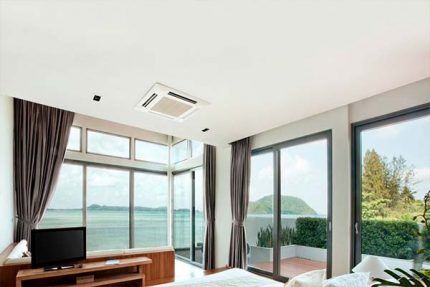
Conclusions and useful video on the topic
An example of installing a cassette unit in a store:
Recommendations for placing duct devices in the room:
Installation of a floor-ceiling system in a restaurant:
The types of ceiling-type split systems considered are distinguished by similar installation and operating principles, but have various positive and negative aspects.
When choosing a unit, you should take into account a set of parameters, technical characteristics and functional features in order to organize air conditioning in the room as correctly as possible.
Would you like to supplement the above material with useful comments? Or do you still have questions about the operating principle or features of choosing a ceiling-type split system? Leave your comments and ask your questions in the block below.




We chose a floor-ceiling split system for our home. We've seen these before at a hotel and liked this option. With such a split system, the interior seems simple. The split system is almost invisible, but works just as well as wall-mounted air conditioners. The model is also well suited to low ceilings, because there is not much space anyway, and if a huge air conditioner hangs on the wall, the design of the room will be ruined.
In my personal opinion, the air conditioner must be of the “floor-ceiling” type, which is usually attached to the ceiling in the apartment. I have a room of 30 meters, in which I work and sleep.
And there is a huge Mitsubishi box hanging. Excellent air flow, smart blinds, instantly cools the air 1 hour before bed.
And at night I always turn it off: you can’t have the air conditioner running at night, it’s a very dangerous thing, from pneumonia to death in half a step.
But I don’t recognize these toys, in the form of a stupid backpack on the wall.They are low-power, they don’t cool the house, and when the concrete is calcined before the iron, they just puff stupidly and only take away electricity, not to mention the fact that they last a short time over the years, there is a high percentage of breakdowns and due to the high load on them, money goes down the drain . A good air conditioner should cost at least 100 grand or more.